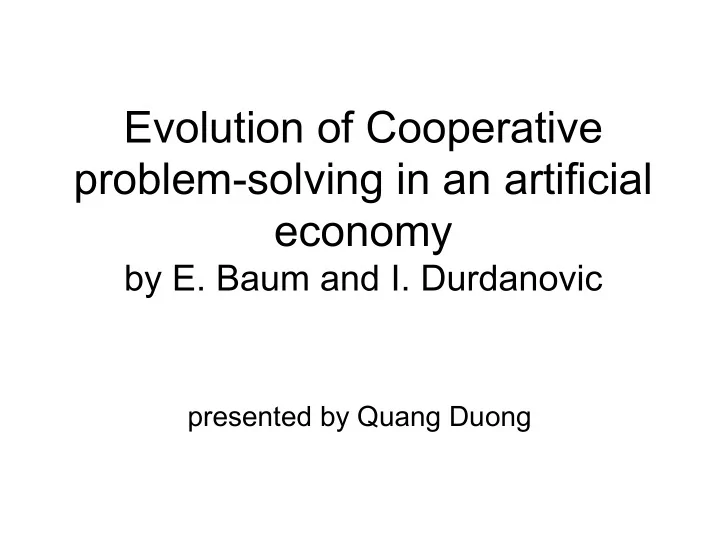

Evolution of Cooperative problem-solving in an artificial economy by E. Baum and I. Durdanovic presented by Quang Duong
Outline • Reinforcement learning and other learning approaches’ limitations • Artificial Economy • Representation Language: S-expression • Block Worlds • Rubik’s Cube • Rush Hour • Conclusion and further exploration
Reinforcement learning • Value iteration, policy iteration • TD learning: neural network, inductive logic programming • Limitation: – state/policy spaces are enormous – evaluation function (reward) is hard to learn/ present – (based on empirical results)
Related work Holland Classifier System: - A set of agents –classifiers: communicate with the world and other agents - Bucket brigade and genetic algorithms • Is it a fair comparison? search vs. plan E.g: GraphPlan, Blackbox
Evolution approach • Artificial economy of modules. • Learn a program capable of solving a class of problems, instead of an individual problem. • Higher reward for harder problems • Revolution: Main problem (external world) External reward action most effective agent/module Artificial economy Internal (internal world) reward (simulation)
Artificial Economy • Hayek: collection of modules/agents Winit set to the largest reward earned • • Auctions: among modules/agents; the winner executes its set of instructions. • Each agent: – Wealth – Bid: min of wealth and the world simulation’s returned value – Create agents if Wealth > 10 * W init • An example… • Assumptions: – only one agent owns everything at a time ! Competing for the right to interact with the real world – conservation of money – voluntary inter-agent transaction and property rights
Representation Language • S-expression: a symbol or a list structure of S- expressions; typed expression !!! • Hayek3; capable of solving large but finite problems
Block World • Max moves: 10nlog3 (k) while k is number of colors
Evolution process • Start: a hand-coded agent • New agent: mutation of the parent agent. • Winit : highest earned reward (initially 0) • Demonstration… • Additional elements: Numcorrect and R node
Block World • Difficulty: combinatorial numbers of states • A class of problems: uniform distribution of size • Result: 100-block problems solved 100%, 200-block solved 90% with 3 colors
Resulting system • 1000 agents • Bid calculation formula: A . Numcorrect + B: – A, B (agent type) – Numcorrect: environment 3 recognizable types: a few cleaners, many stackers, closers (say Done) Macro-action. Example: Approximate Numcorrect. R(a,b) node.
Meta learning • 2 types: Creator (don’t bid): modify or create – otherwise, Solver. • Example… • Result: show 30%-50% better performance after a week of execution. • Limitations: – expensive matching computation – shows no better performance than the simple Hayek system
Example
Rubik’s cube model variations • 2 schemes: – Scrambled in one rotation, reward only for completely unscrambling. – Completely scrambled, partial reward: (1) number of correct cubes (2) number of correct cubes in a fixed sequence (3) number of correct faces. • 2 cube models • 2 languages. • Limitations: after a few days cease to make progress due to: – More difficult to find new beneficial operators without destroying the existing correct part. – Increasingly complex operators Less structure to be exploited
Rush Hour • Challenges: possible exponential move solution, representation language • Expressions are limited to 20000 nodes • Note: the use of Creation Agents. • Learn with subsampled problems (40 different instances)
Rush Hour (cont.) • The ability of agent to recognize distance from the solution (low bid for unsolvable problem) • Reward: • Break down to subgoals • Genetic algorithms never learned to solve any of the original problems
Conclusion • Property rights and money conservation • Learning in complex environment will involve automated programming • Problem: space of programs is enormous • Hayek: creates very complex program from small chunk of codes • Suggestions: trade info, single and universal language
!? • Comments? • Applications? • How related to the course?
Recommend
More recommend